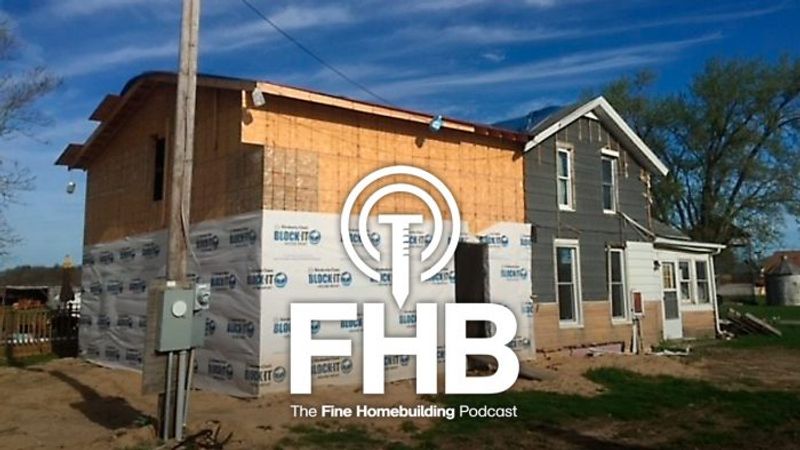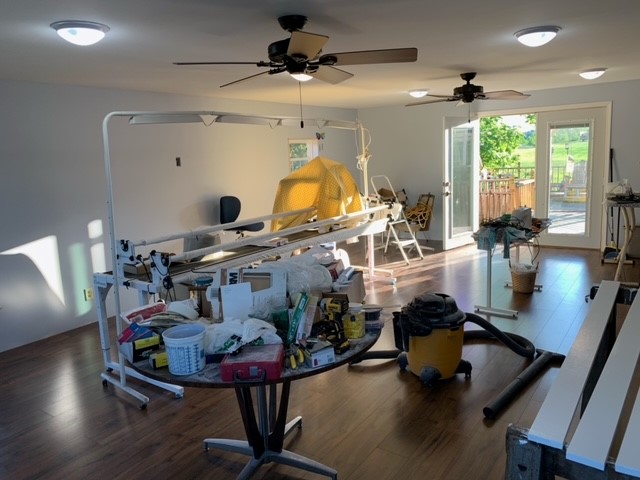Podcast 305: Asbestos Flooring, Panned Return Ducts, and Adding On to a Log Home
Brian, Kiley, and Patrick hear from listeners about urban lumber and small-engine oil before taking listener questions on asbestos-contaminated flooring, metal panning for ducts, and a two-story addition for a log home.

Follow the Fine Homebuilding Podcast on your favorite app. Subscribe now and don’t miss an episode:
 |
 |
Help us make better episodes and enter for a chance to win an FHB Podcast T-shirt:
www.finehomebuilding.com/podcastsurvey
Bucky teaches the crew about the Raber-Hutchinson comfort equation. Chemist Matt talks about engine oil. Andrew asks if he can put new flooring over his asbestos-containing existing flooring. Craig wants to know the best way to arrange exterior insulation and sheathing layers. A second Matt wants to know what to do about the panned joist bays acting as return ductwork. Jeremy asks if there are any concerns when adding on to a log home.
Editor Updates:
- Kiley’s fascination with an unfinished house
- Brian’s ladder-carrying technique
- Patrick’s suburban-dad house jobs
Listener Feedback 1:
Bucky from Boone, NC writes: I’m a new listener and am having a little trouble submitting listener feedback. Maybe this is because I’m not yet a subscriber but will be soon I suspect. Also, for some reason the listener questionnaire wouldn’t load past the second question for me.
Long story short, I’m a small, one man, boutique lumber producer, Resource Wood Inc. dedicated to urban or community lumber, that is salvaging logs for lumber that big mills don’t want or overlook. I’ve also gotten into building masonry heaters and pizza ovens as a good use of fuel grade wood that can’t be made into lumber. The Masonry Heater Association of North America is a great organization that meets once a year here in western North Carolina in April for one of the best building science conferences anywhere in the world.
The latest FHB Podcast discussed, in a nutshell, thermal comfort in a house as it relates to convection and radiant heat. The presenters should familiarize themselves with the Raber-Hutchinson comfort equation. From Greenstoneheat.com: The Raber-Hutchinson comfort equation theorizes the temperature of ambient air plus the mean radiant temperature of surrounding surfaces will equal 140 degrees Fahrenheit. In other words, if the MRT is 70º F, the air temperature must also be 70º F to maintain comfortable conditions. And for every degree drop in MRT the room air temperature must increase by one degree to maintain comfort for the people in the room. This also explains why you can be comfortable in your home in the summer time wearing a t-shirt, with 68-degree air temperatures, while in the winter time you can be cold in the same room with 72 degree air temperatures, while wearing a sweater. The radiant energy of the sun is stronger in the summer, which raises the MRT for all the solids that make up your home.
Similarly, a masonry heater directly heats the solids (including the people), increasing the MRT in your home, allowing you to be comfortable at lower ambient air temperatures. Since convective heating devices do little to raise the temperature of the solids in the room, the air temperature must be higher to keep its inhabitants comfortable.
I think that Raber-Hutchinson succinctly expresses what the podcast hosts where driving at.
Please share my contact information with any of your people if I can help you in these areas.
Listener Feedback 2:
Matt from northwestern PA writes: Hello FHB podcast folks, I appreciate all of the insight and intellectual discussions you share with us viewers. Catching up on past episodes has made my daily commute much more enjoyable. My lengthy response is directed towards Patrick’s generator oil question in Episode 281.
As a research and development chemist at a small refiner/lubricant manufacturer in northwestern PA, I believe I can offer some insight into the “which oil brand should I use?” topic that was discussed. Collin was correct in his assessment that Yamaha does not have a special patent on the oil prescribed in your generators owner’s manual. Using a different brand oil will not be problematic, as long as the chosen oil meets the specified API Service Category.
However, that is where small engines “don’t get no respect.” The current API Category, updated in May of 2020, is ‘SP.’ This particular update primarily addresses low speed pre-ignition, fuel economy, and timing-chain wear by shifting detergent packages from calcium base to magnesium base and organic friction modifiers to molybdenum specific inorganic modifiers; none of which is of high importance to a generator and other small engine equipment.
For this reason, I steer towards the Japanese Automotive Standards Organization (JASO) that is aimed towards motorcycle and scooter small engines. These lubricants are often referenced for use with generators and small power equipment, as the operation parameters align more closely than they do with those of cars and trucks. While still produced with high performance additives and base oils, JASO
categorized, or specifically marketed “small engine oils” may be more affordable as they do not contain the expensive chemistries earlier mentioned, and are cross-compatible with previous API Categories.
Matt also mentioned ethanol free gasoline. I recommend this in all small engines, especially in a generator that may sit idle for long periods. Ethanol is hygroscopic and can absorb enough water to rust critical engine components over time. If the generator is stored in a garage attached to a leaky house or a frequently utilized workshop, I advise using high octane pre-canned fuel. Although costly, it has virtually no detectable amount of benzene. In fact, some brands pre-canned fuel is a straight alkylate product that is low in concentration of additional respiratory irritants such as toluene, ethylbenzene, and xylene.
Hope this information helps and keep up the great work.
Related Links:
Question 1: Should I just cover up the asbestos flooring in my laundry room?
Andrew writes, FHB Podcast, I’m looking for your opinions on my laundry room flooring. My house was built in 1977, and the laundry room has a smelly indoor/outdoor carpet on the floor. A container of bleach recently fell, which only served to change the smells. I decided to rip up the carpet and tile the floor, which has been on my to do list for a while.
I removed the rubber baseboards (which always make me think of commercial buildings) and started to pull back the carpet. It was glued down over, as I discovered, sheet linoleum. I decided to have a sample tested and, you guessed it, the linoleum is 30% chrysotile asbestos. The carpet mastic is non asbestos, and the adhesive holding the sheet linoleum down was inconclusive, although it didn’t appear to be the black asbestos mastic of yesteryear.
The laundry room is small (about 30 square feet), so costs for a professional asbestos removal are prohibitive (the estimates are about $800 to $1000). I’m not sure how intact the linoleum is under the carpet – presumably there might be some wear if they decided to carpet over it.
What options do I have to change the flooring? If I suck it up and pay big bucks to have it professionally removed, I can tile it like I wanted, but I’m trying to understand other options.
Can I put plywood over the carpet and put vinyl plank flooring? Maybe glue the planks down to this plywood subfloor so I don’t have to worry about them coming apart when I move the washing machine and dryer.
Could I put cement board down and tile that? Would the cement board need to be screwed down – and if so I guess I’d try to hit the floor joists so I’m not releasing asbestos dust into the air in the basement.
If I pull up the carpet, I’ll have the carpet mastic all over the linoleum, which seems like a pain to clean. But if the carpet stays presumably some of the smell stays too.
I’m just trying to understand my options in here before dropping big money on professional abatement. Thanks and I love the podcast. You all bring your own expertise and it seems like you genuinely enjoy each other’s company.
Related links:
- How Worried Should You Be About Asbestos in Older Homes?
- Refinishing Floors Safely
- Why Expensive Asbestos Litigation Just Won’t Go Away
Question 2: What’s the best way to install exterior insulation and a new air barrier on an old home?
Craig writes, Hello Fine Home Podcast, I have a house build in the 1860’s with alum siding that’s over a black tar like blocks and then the old wood siding. I would like to tear it all off and put 1″ foam board with an R5 and then 1/2″ plywood with vinyl siding. What is the best way to do this put the foam board on the studs then the plywood so it will make a thermal barrier and nail the siding to the plywood or the plywood first then foam board.
I’m sending a picture of our room addition, wife’s sewing/quilting room. All I have left with the addition is to side it, the rest is done. Thanks for any help.
 |
 |
Related Links:
- Thermaltight
- Is Your Exterior Rigid Foam Too Thin?
- Installing Rockwool for Continuous Exterior Insulation
Question 3: Do I need a to hire a pro to install metal HVAC ducts?
Matt from Chagrin Falls, OH writes, Hi FHB crew. Since the pandemic began, I’ve been slowly applying the knowledge I’ve acquired listening to your podcast and reading Fine Homebuilding to re-insulate and improve a semi-finished basement area in our 1979 ranch home. After removing the old drop ceiling panels, which doubled as the flooring for a mouse version of Studio 54, and sealing all exterior gaps and leaks around the mud sill, I’d now like to install some much-needed soundproofing (mineral wool and drywall) to the ceiling. Before doing so, however, I wonder if I should first address the presence of panned (air duct) returns between the floor joists while I have the opportunity. I’ve listened to your podcast long enough to appreciate that these returns aren’t the most efficient way to seal a duct – especially when I can see that coaxial cable has been fished through them! – and can hardly stomach the thought of what my family has been breathing in the last decade. After combing through some of FHB’s archived materials and podcasts, it’s unclear to me whether a DIY-friendly alternative to panned returns exists…or if my only recourse is to hire an HVAC contractor to run new ducts using sheet metal ($$$). Although imperfect, might the use of duct board, for instance, provide a tighter, cleaner solution to the current setup? Or – am I better off simply sealing the visible gaps and cracks with mastic or spray foam as best I’m able?
It’s been a real pleasure listening to you all during the past several months; your good cheer and professionalism has been a welcome distraction!
Related Links:
Question 4: What do I need to think about when connecting a well-insulated addition to a log cabin?
Jeremy writes, Hey FHB Crew, I am relatively new to the podcast and am burning through episodes. The info has been extremely helpful with our small remodeling/construction business. I tell customers and employees all the time that things are done incorrectly for two reasons: ignorance or laziness or a combination of the two. Listening to the podcast reduces my amount of ignorance (I still have a long way to go). It provides lots of answers, but more importantly it makes me aware of when I should be asking questions.
In January, we’re building a two-story addition attached to a log cabin. What things should we be considering? Obviously, the addition will be much better insulated and more air tight. We are planning to put Zip R on the exterior for added R value and air sealing with fiberglass batts in the cavities. We are going to drywall the second-floor ceilings before framing the partition walls. The ceiling will have blown cellulose. Does this increased tightness & insulation pose any problems with the existing cabin?
Additionally, I understand roof venting is ineffective in most cases, but what about gable vents? And powered vents? Are these effective?
Lastly, I laugh when discussions of air sealing and blower door tests come up. At our house, ACH is an incalculable number. Instead, we use ACS–air changes per second. We have five young children and air sealing goes something like this: “Please shut the door. Please shut the door again. Please shut the door all the way. Just stay in or stay out. I am going to lock you out of the house. What do you mean you left the window open so the bird could get out of the cold?” And on and on…
Related Links:
End Note: Fine Homebuilding will soon celebrate its 40th anniversary…stay tuned for special features from our archives!
Visit the Taunton Store • Magazine Index • Online Archive • Our First Issues • All Access
Help us make better episodes and enter for a chance to win an FHB Podcast T-shirt: www.finehomebuilding.com/podcastsurvey
If you have any questions you would like us to dig into for a future show, shoot an email our way: [email protected].
If we use your question we’ll send you a FHB Podcast sticker!
FHB Podcast T-shirts!
Represent your favorite podcast! Available in several styles and colors. Made from 100% cotton. Find the Podcast t-shirt and more cool products in the Fine Homebuilding Store.
This episode of the Fine Homebuilding podcast is brought to you by BuildBook.
Happy Clients. More Profits. Less Stress. That’s the trifecta of the construction business. We all want that, right? Well, after working and talking with 100’s of home builders and remodelers over the past 2 years, BuildBook has discovered the one common ingredient that determines the success of your construction business…the client experience.
Yes, if you drop the ball anywhere in the client experience from the first impression to the final payment, things can get super messy super quickly.
BuildBook has spent the past several months developing the first-of-its-kind platform that focuses on helping you deliver throughout the client journey the one thing standing between you and achieving the trifecta of construction.
It starts with marketing tools to attract the right leads. Add in sales tools so you can win the best projects. And finish with project tools that knock your clients socks off!
If you’re looking for an unfair advantage in your business, this is it. Head on over to BuildBook.co now to try it free for yourself.
Visit BuildBook.co for more.
Fine Homebuilding podcast listeners can get 20% off anything in the Taunton store, including the Renovation, 5th Edition.
Use the discount code FHBPODCAST to take advantage of this special offer.
We hope you will take advantage of a great offer for our podcast listeners: A special 20% off the discounted rate to subscribe to the Fine Homebuilding print magazine. That link goes to finehomebuilding.com/podoffer.
The show is driven by our listeners, so please subscribe and rate us on iTunes or Google Play, and if you have any questions you would like us to dig into for a future show, shoot an email our way: [email protected]. Also, be sure to follow Fine Homebuilding on Instagram, and “like” us on Facebook. Note that you can watch the show above, or on YouTube at the Fine Homebuilding YouTube Channel.
The Fine Homebuilding Podcast embodies Fine Homebuilding magazine’s commitment to the preservation of craftsmanship and the advancement of home performance in residential construction. The show is an informal but vigorous conversation about the techniques and principles that allow listeners to master their design and building challenges.
Other related links
-
- All FHB podcast show notes: FineHomebuilding.com/podcast.
- #KeepCraftAlive T-shirts and hats support scholarships for building trades students. So order some gear at KeepCraftAlive.org.
- The direct link to the online store is here.




























